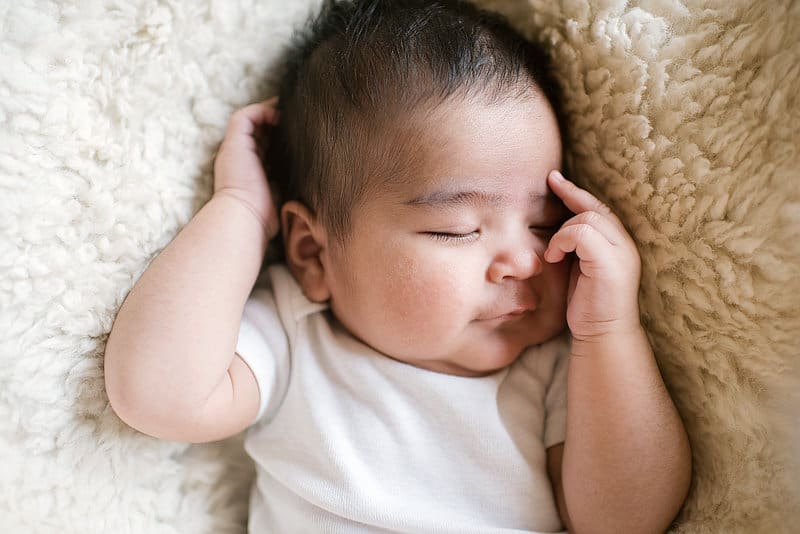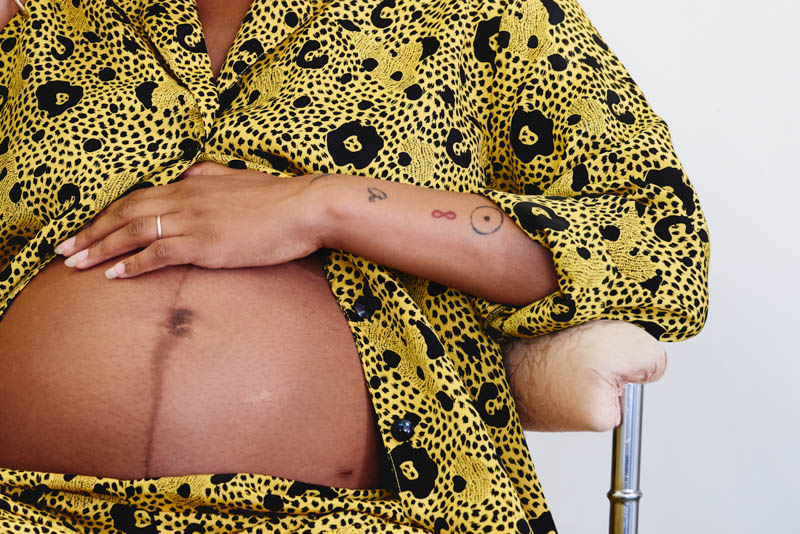
Baby Sleep Cycles, An Explanation
Written by Aja Lake
Photography by Baby Dayton Photographed by Sarah Hebenstreit
When you’re raising a new baby, you’d do just about anything to have a “good sleeper” on your hands. According to sleep researcher Dr. Polly Moore, this might be an easier goal to attain than one would think. In her book, The Natural Baby Sleep Solution, Dr. Moore explains the science behind a baby’s 90-minute sleep cycle, which led her to develop a system she calls “N.A.P.S.” In essence, this simple approach guides parents through the alertness cycles of babies aged two weeks to one year, helping to build a foundation for better sleep in toddlerhood and beyond. Interest piqued? Below, Dr. Moore breaks it down for all of the sleep-starved babies and mamas out there. We say: It sounds simple enough to give a whirl!
Your N.A.P.S. plan is based on the BRAC. What is that?
“The BRAC is the Basic Rest and Activity Cycle. All living humans have a 90-minute BRAC, or 90-minute clocklike rhythm inside them that runs many aspects of our physiology, like blood pressure or creative thinking or secretion of certain enzymes. It was discovered in the 1950s by researchers named Aserinsky and Kleitman, shortly after the discovery of REM sleep. Many animals in the zoo, mostly the mammals, also have a BRAC (these are usually the animals that also have REM sleep), and each species seems to have its own duration of BRAC. The BRAC seems to regulate the timing of REM sleep and it also seems to regulate other aspects of physiology. That’s about as far as we understand it. Recognizing this rhythm erased much of my uncertainty about sleep.”
How do you determine a baby’s sleep rhythm?
“In order to predict the next window of sleepiness, you need to know a.) What time the baby woke up and b.) what time it’ll be when you add 90 minutes to that first time. That’s it. That’s the ‘program.’ As babies get older, they become able to stay asleep for longer than 90 minutes, but the extension of the wakeful period appears to always or nearly always be in increments of 90 minutes. They become able to stay awake comfortably for 3 hours (two 90-minute windows back to back) before you see the sleepy signs.”
What are the signs a baby is ready to rest?
“It can take a lot of different forms. Some signs are the usual suspects, such as yawning, eye rubbing (when they develop that skill), or losing interest in an activity. The signs can also be more subtle, like smiling and interacting with you and then suddenly their gaze drifts away to an inanimate object. Some babies become irritable. Some babies cry or become fussy when they’re fatigued. Some babies do a combination of these things. This is why the N.A.P.S. plan spells out the rhythm, so that if you’re not clear on your baby’s signs of sleepiness, you can at least know when to pay attention so you can figure it out.”
What happens if your baby consistently wakes up too early from a nap or resists sleep?
“Often when I’m working with families with a baby that wakes up ‘too early,’ it is successfully addressed either by 1.) putting the baby to bed earlier (and not later as you might suspect) or 2.) reinstating the afternoon nap. For adults, you’d want to do the opposite, and sleep deprive the adult a little bit to increase the sleep drive at night. So, this is very counterintuitive for people. But especially in the very young, sleep begets (more) sleep. Short naps come from falling asleep at a different point of the 90-minute clock cycle, a cycle which runs continuously. Long naps are achieved when one follows the 90-minute cycle. In a newborn, the next nap opportunity is just around the corner. My book goes into more detail on how these expectations can change as babies get older. Often sleep resistance happens because of the misunderstanding that the baby will get sleepier the longer you wait (which has variations at different ages). But the N.A.P.S. idea is once you get the hang of your baby’s sleepy signs, which can be cryptic or counterintuitive, you need to respond fairly quickly or the sleepy zone is missed and they’ve moved on into the next alert cycle, and won’t be sleepy again for another 90 minutes.”
Should sleep be interrupted or should a child be left to wake on their own?
“Waking naturally helps your baby’s brain to discharge the energy built up during wakefulness. A natural waking teaches the baby how to sleep until this and other neurological housekeeping tasks in the brain are completed. If the baby is frequently awakened artificially from her daytime naps, her brain doesn’t get the same opportunity to learn these lessons, and the result is shorter sleep length—both at naps and at night. Even if you are concerned that a nap or morning sleep has gone ‘too long,’ do not wake your sleeping baby. The same is true for toddlers, by the way—and it would be a wonderful world if teenagers and adults could also arise according to their own rhythms instead of alarm clocks. Think of it this way: Sleeping is like breathing. Your baby can’t breathe too much today and not need to breathe tonight. The same goes for sleep.”
What should napping look like at different stages?
“At birth, a baby will sleep between 14-20 hours per day. From about two-weeks-old through the third month, when the 90-minute cycle takes effect (if it hasn’t already), babies will sleep about 16 hours daily, although a regular nap schedule may not yet be developed. At three- to five-months-old, a baby will still sleep 14-15 hours each day. By months four or five, bedtime moves earlier and you will probably see naps consolidate into predictable sleep periods. Many babies take a morning nap, an afternoon nap, and an evening nap, but don’t worry if your baby needs more naps or fewer. At this age, your baby may also develop the ability to stay awake for longer periods (usually lasting 3 hours or 4 1/2 hours) during the day. By six-months-old, babies will sleep up to 14 hours per day. You may have have already seen your baby develop longer periods of wakefulness in the evening and/or morning; now your baby may also show a 3-hour window of alertness between naps. Look forward to some rest now! Most babies who can fall asleep by themselves will start to sleep all the way through the night. From eight- to twelve-months-old a baby may still require up to 14 hours of sleep, but may have dropped the evening nap. Don’t pressure your baby to give up her morning nap. It may shorten, but most infants need a morning nap until they are twelve- to eighteen-months-old.”
Do children ever really outgrow naps?
“The way you can know that your child still needs a nap is if his or her behavior breaks down completely in the second half of the day, or the child shows uncharacteristic outbursts of anger or has difficulty enjoying activities you know they like. Missing a nap can affect a child’s attention span, we all know it and have seen it. It affects their ability to manage their emotions. Just because they can stay awake during nap time does not necessarily mean they have outgrown the need for a nap. It helps if you’ve established a consistent bedtime at night. When my kids started to resist the naps at age 3 or 4, we used a stickerboard on the fridge, they would put a sticker for each day they napped, and at the end of the week they got something special. My kids were the kind that did not tolerate sleep loss very well, it affected their thinking and their emotions and even their physical abilities. The whole rest of the day would be affected, really.”
Should school-age children have a rest period in the afternoon?
“I believe children should have a rest period in the afternoon. I don’t know how we expect kids to learn if they don’t get opportunity for decent rest. Also, I don’t understand how naps got such a bad rap! I believe people mistakenly think that outgrowing a nap at an early age is a sign of intelligence. I assure you it is not; there are no data to support that supposition.”
For more on Dr. Moore’s N.A.P.S. program, check out The Natural Baby Sleep Solution, $9.08, Amazon.
Share this story



